
If you are looking for a way to use fewer pesticides, less water, and create shelter and food for wildlife, then native shrubs may be a great addition to your garden.
Some Benefits of Native Shrubs
- Native shrubs are adapted to our environment. This means keeping them alive year-round may not be as difficult in the long term as more cultivated plants.
- They don’t require as much water and can also reduce rainwater runoff and even erosion in the landscape.
- They provide nectar, pollen, and seeds that serve as food for pollinators and other animals.
- They conserve water because they are adapted to our area.
- They do not require fertilizers and require fewer pesticides than lawns.
- Native plants do not require mowing. Excessive carbon is created by lawnmowers and other gas-powered equipment and can contribute to global warming. These plants actually remove carbon from the air.
- Native plants provide shelter and food for wildlife.
Some Top Native Shrubs for the Pacific Northwest:
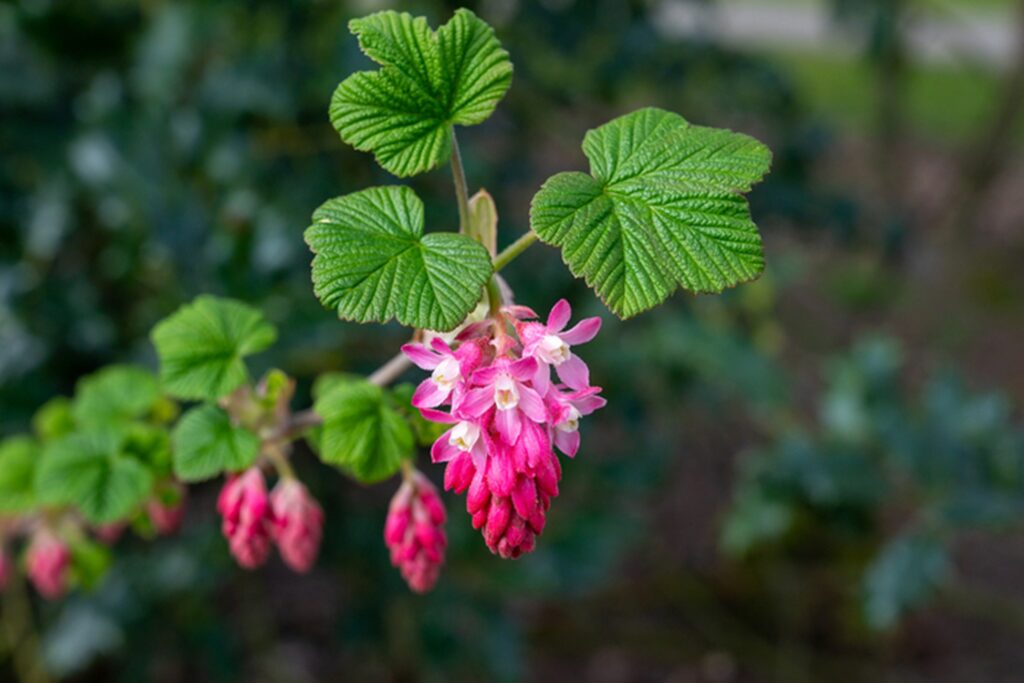
Red-flowering Currant (Ribes sanguineum)
This shrub really brightens up your garden in early spring. It is a favorite of hummingbirds. Other birds also enjoy the berries, but they are non-edible to humans. Red-flowering Currant grows upright to between 3 – 9 ft. tall.
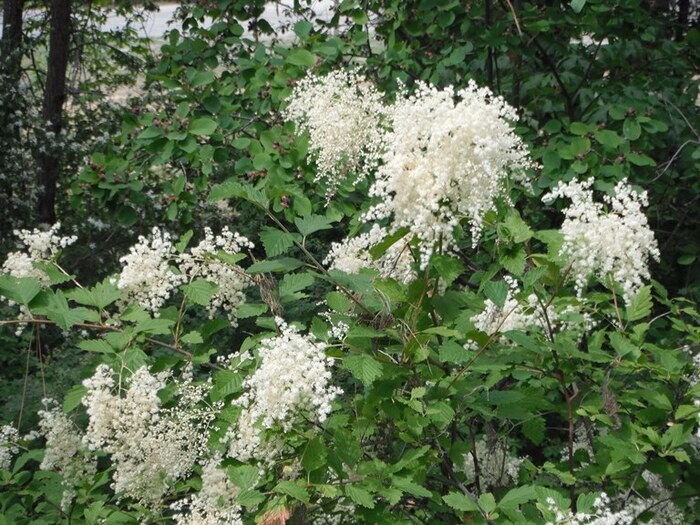
Oceanspray (Holodiscus discolor)
Oceanspray has cascading, creamy-white flower clusters and an arching habit. It is also known as Ironwood due to the strength of its wood. It can range from 2- 20 ft. tall. Oceanspray is drought tolerant and likes the sun. It blooms in June and July.
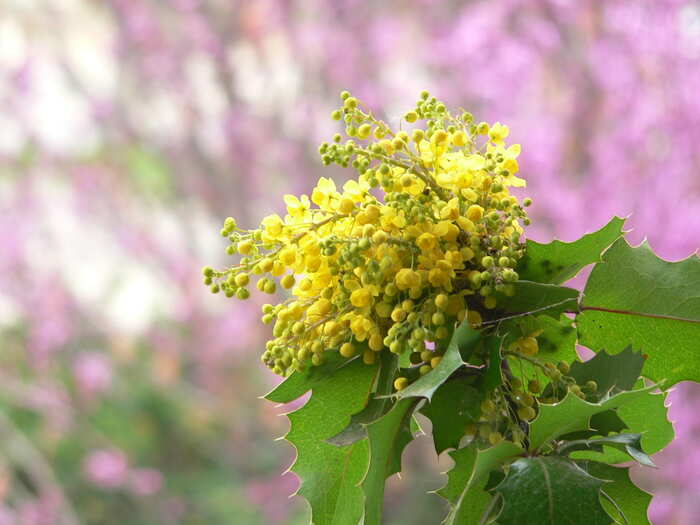
Tall Oregon Grape (Berberis aquifolium)
Oregon Grape, the state flower of Oregon, has attractive foliage, yellow flowers, and blue “grapes.” It can be used as a hedge plant and is evergreen. Oregon Grape can get up to 6 ft. tall and 3 ft. wide.
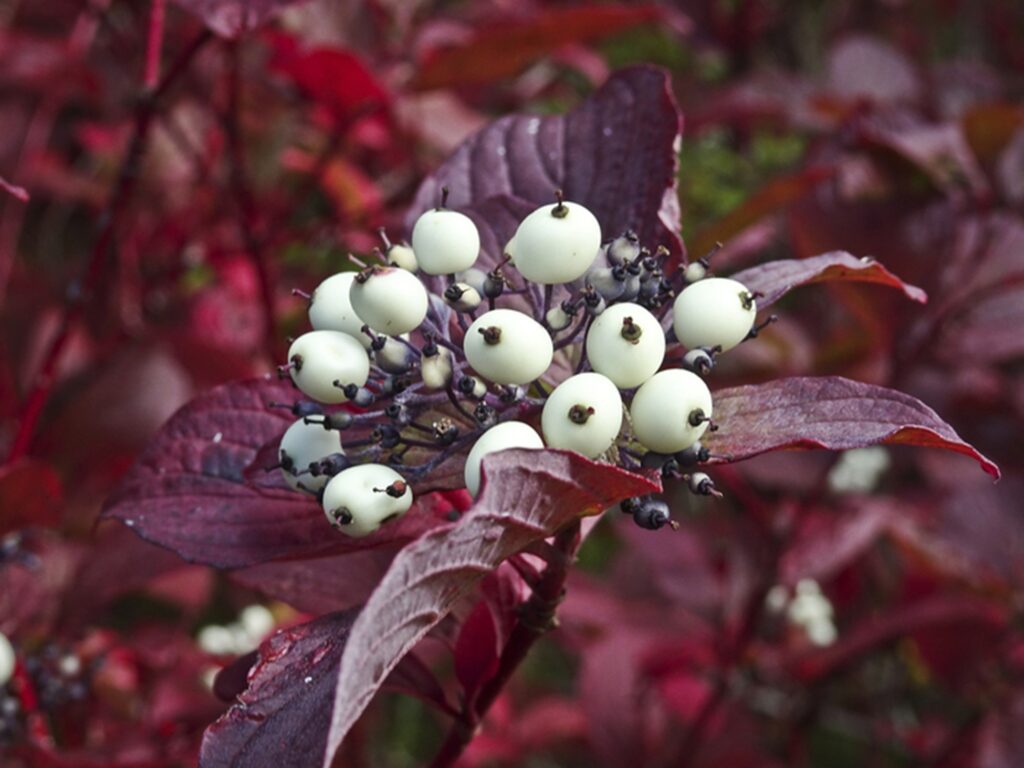
Red-osier Dogwood (Cornus sericea or Cornus stolonifera)
This fast-growing shrub has year-round interest. Its red twigs are pretty, followed by leaves of reddish burgundy. The white flowers are sometimes present with the white berries. Birds are attracted to Red-osier Dogwood. It likes fairly wet soil and can grow in full sun from 3 – 18 ft. tall.
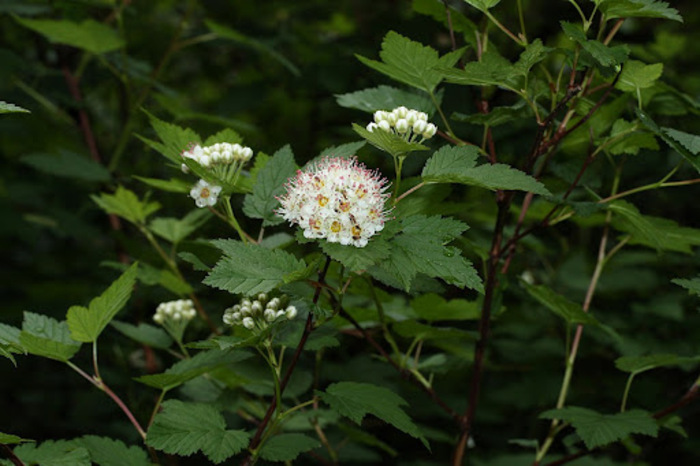
Pacific Ninebark (Physocarpus capitatus)
This native shrub has year-round interest. Pacific Ninebark has glossy leaves and puffy white flowers that turn red in the fall and then to yellow seeds. The leaves turn reddish-brown. In the winter, the branches have peeling reddish-colored bark. This shrub can be planted in the sun or shade. It grows 10-15 ft. tall and is attractive to butterflies.
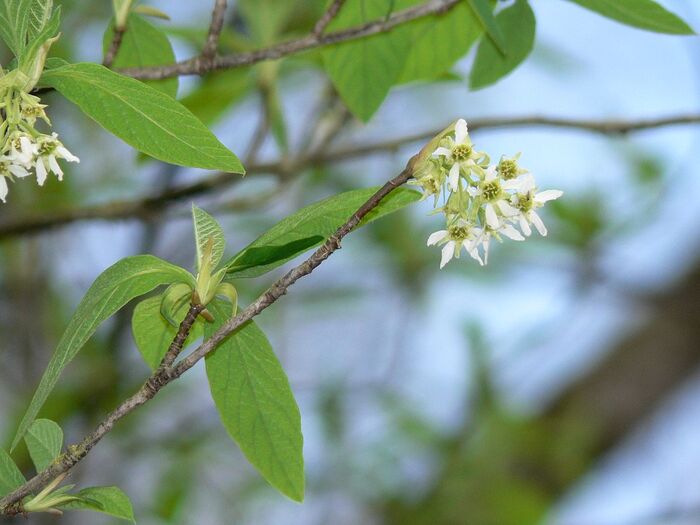
Indian Plum (Oemleria cerasiformis)
The Indian Plum is attractive to birds such as cedar waxwings and is also eaten by mammals. It grows as a multi-stemmed shrub to between 5 – 20 ft. tall. You need male and female plants for fruit. The bittersweet small fruit ripens in the fall and can provide winter feed for birds and other wildlife. It is one of the first shrubs to flower in the spring (February). It attracts bees and flies as pollinators.
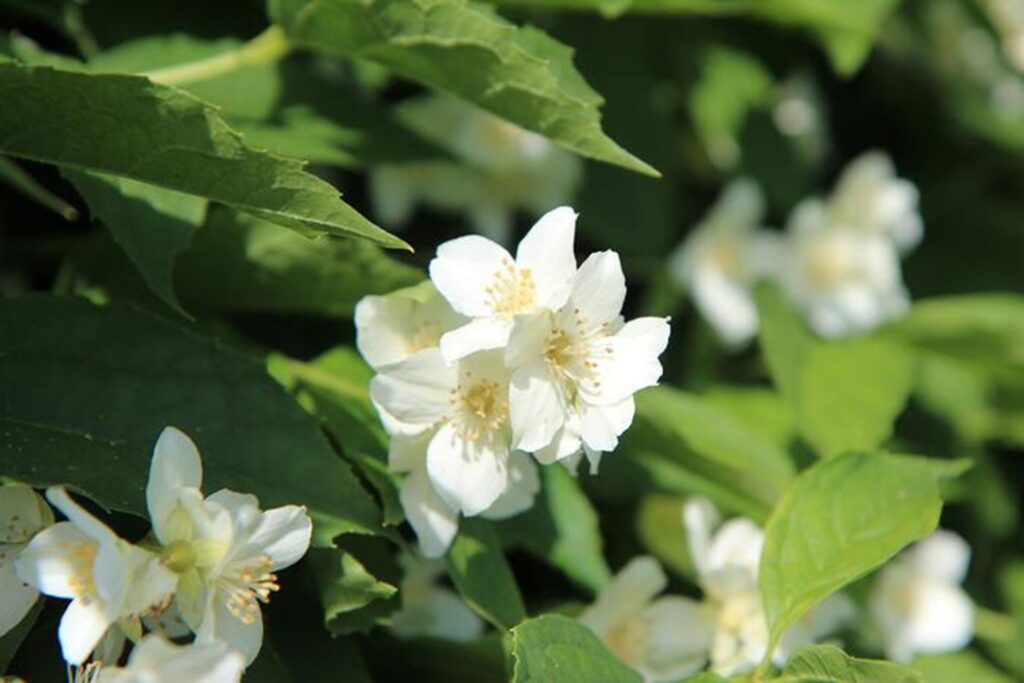
Mock Orange (Philadelphus lewisii)
Mock Orange has white fragrant flowers in the summer. A hardy shrub, it can be planted in full sun or part shade. Birds are attracted to this shrub, which can also be used as a hedge plant. The flowers attract moths and other pollinators. It grows from 6- 15 ft. tall.
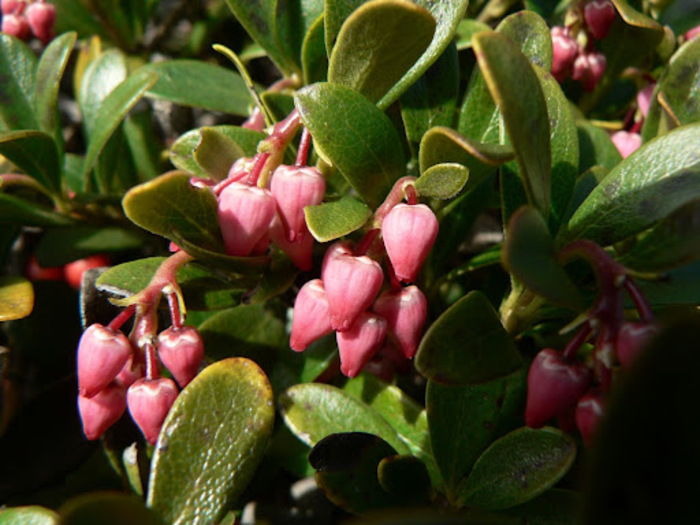
Kinnikinnick (Arctostaphylos uva-ursi)
This native evergreen shrub not only has a fun name but is also attractive to birds and insects. Kinnikinnick is low maintenance and has pink hanging bell-shaped flowers that bloom in the spring. The red berries appear from July and last through winter. This plant prefers sun and well-drained soil but can also tolerate some shade and soil variation. Kinnikinnick is used as a groundcover and grows up to 3 ft. wide.
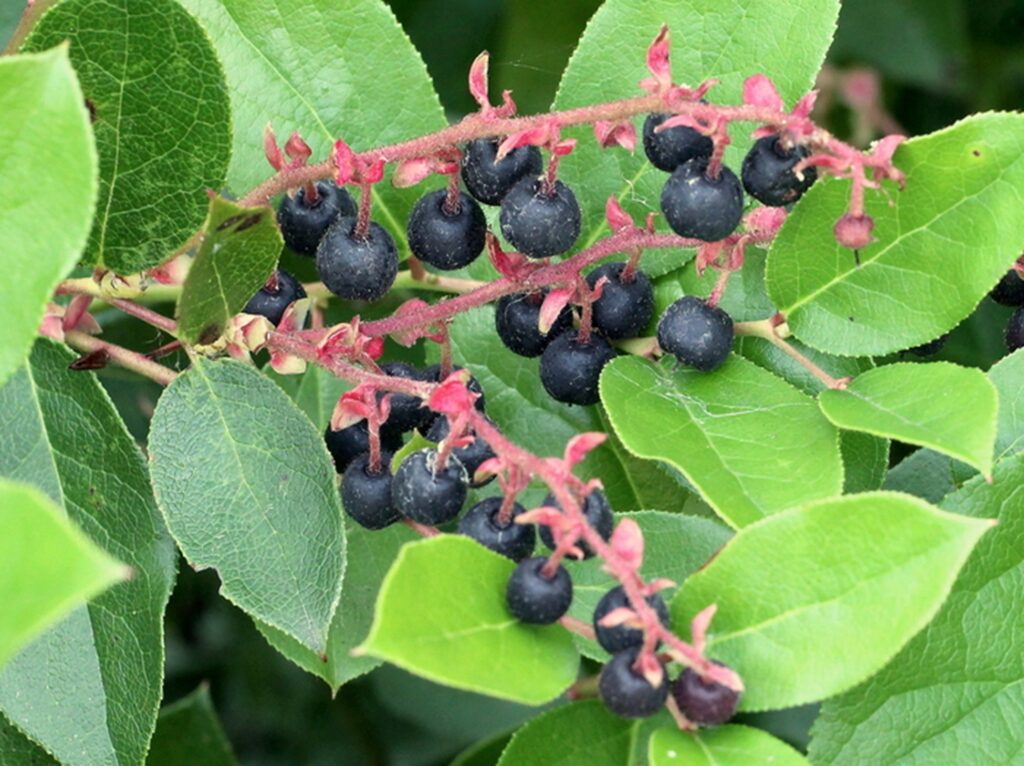
Salal (Gaultheria shallon)
Salal is also known as Oregon wintergreen and is an evergreen native shrub. Salal can grow to over 6 ft tall in the shade and 3 ft. in the sun. It has urn-shaped flowers that are white to pink in color and bloom in April and May. The edible (but mealy), dark-purple berries ripen from July to September. As a common forest understory shrub deer and elk eat the leaves mostly in winter. The berries are eaten by birds and squirrels and the flowers attract hummingbirds.
At Frontier Landscaping we can help you design and install a native plant garden or incorporate more native plants into your existing landscape. Give us a call for a free consultation at (360) 574-8979.
If your garden looks more like an urban jungle this spring, there are tasks you can do for a spring yard clean-up.
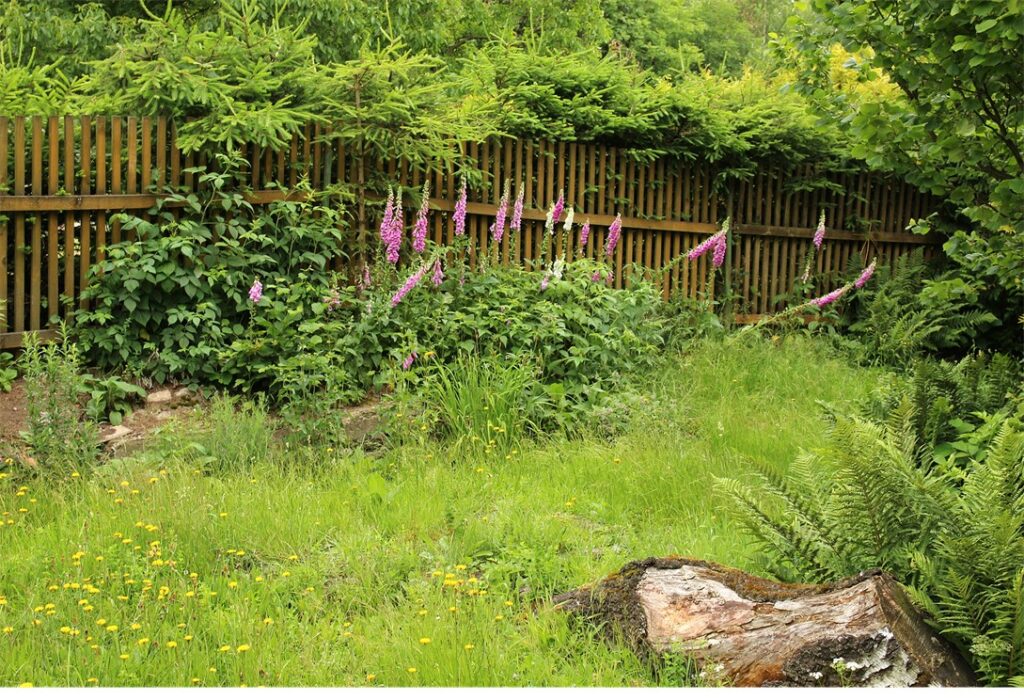
Just like your house may need spring cleaning so does your yard. There are several spring yard tasks to complete this time of year.
Yard Tasks For Spring
Remove Yard Debris
First, remove yard debris like tree branches or twigs that may have fallen over the winter. Rake up leaves that may be covering your lawn from fall or blew in during heavier winds. This winter and spring we have had wind, hail, snow, rain, and sunshine, sometimes all on the same day! Your landscape may have taken a beating.
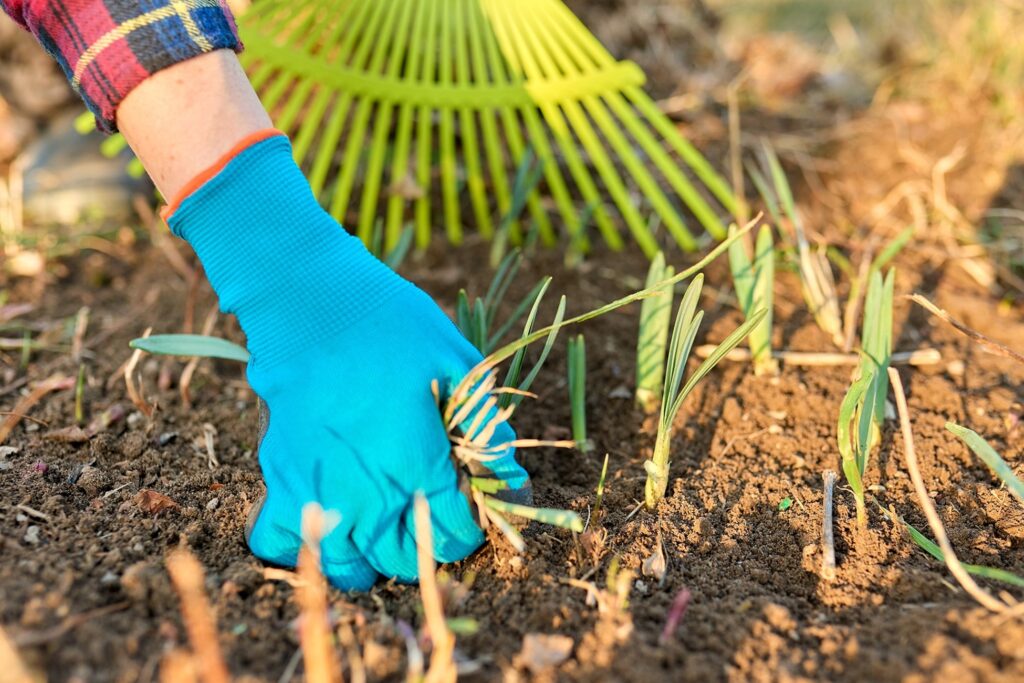
Get a Head Start on Weeds
The weeds are starting to emerge or maybe they never left for the season? Getting a head start on weeding can help you prevent a bigger problem later in the year. Debris removal of weeds is important so they don’t reseed themselves and regrow.
Add Fresh Mulch
Adding fresh mulch as a top layer in planting beds will instantly help spruce up the look of your yard and help your plants retain more moisture this summer. Mulching also helps keep weeds from taking over before you can pull them by cutting off their light source to grow.
Prune Your Plants
Prune back trees, shrubs, and plants to enhance the plant health and appearance of your property. Remove deadwood on plants and look to see if there are any shrubs or trees that may need removing.
Remove any dead growth on perennials and consider dividing them if they have grown large enough. Consider dividing bulbs or larger perennials. By dividing perennials you can add more interest to other parts of your yard for free.
Add Soil Amendments
Adding compost or fertilizer to the soil around your plants is also a good idea to keep your garden looking healthy for the season. A well-cared-for landscape can also increase your property value and may prevent trees and other plants from failing health later on.
We Can Help With Your Spring Yard Clean-Up
Frontier Landscaping offers not only seasonal yard cleanups but also land and brush clearing and debris removal for properties that may have been reclaimed by nature with extensive weeds and blackberries. When our team has finished with your yard clean-up, your property will be ready for any new project or space you wish to create this spring!
If you are feeling overwhelmed, need a one-time service, or regular landscape maintenance you can count on Frontier. Call or email us today for a free estimate on spring clean-up! (360) 574-8979 or [email protected].
Landscape Drainage Solutions to Help Problem Areas
We get our fair share of rain in the Pacific Northwest, so it’s not uncommon to have some landscape drainage issues. Adding a rain garden or a dry creek bed are great drainage solutions that can even enhance the look of your landscape.
Water drainage problems in your yard decrease property value and can lead to costly water damage to your house and other structures, as well as plant and turf damage. With a little planning, you can alleviate your drainage issues to protect not only your yard but also your home.
How to Check Your Yard for Drainage Issues
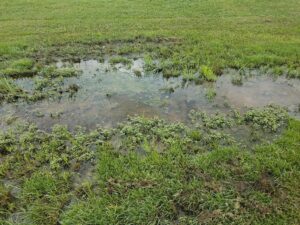 Pay attention to where the trouble spots are in your yard. Are there slopes that could be leveled out, mulched, or other materials added for draining? Is there an area with runoff from the driveway or gutters?
Pay attention to where the trouble spots are in your yard. Are there slopes that could be leveled out, mulched, or other materials added for draining? Is there an area with runoff from the driveway or gutters?
To get a rough idea of where the problems lie, take advantage of heavy rains to watch what happens to the water. Does it gush from the gutter and flood your flower bed or pool below your deck? Is there an area in your yard that becomes a swamp – or that remains swampy all year? Lawns and plants will die and/or become susceptible to disease and pest problems if they’re not able to dry out.
Does water run across the driveway or into the street during a hard rain or, worse yet, soak areas around your home’s foundation? In some cases, the grade was not established correctly and did not take into account that the ground should slope down and away from the house.
Level a sloping yard. To avoid incoming water, the ground should always slope away from your home in all directions. Locate the high and low points of your home and use extra soil to slope the yard away from your house. Melting snow and rain will flow away from your home.
Landscape Drainage Solutions
Native Plants
Choose native plants that prevent flooding in your yard. Native plants can help to prevent soil erosion while also allowing rainwater to drain more efficiently. Some selections for our area are Slough Sedge, Western Columbine, and Pacific Ninebark.
Mulch
Using mulch in your garden can prevent water from flowing toward your home. In garden areas, grade away from your home and fill with a few inches of mulch. This will help keep soil in place and hold in rainwater. If mulching near your home, make sure the mulch is at least six inches from your siding to avoid moisture wicking and rotting of your home’s exterior.
Rain Garden
Consider planting a rain garden. Rain gardens are the perfect solution for curbing erosion and improving water quality. They collect rainwater and water that runs from your gutters and downspouts, creating runoff and filtering it away from your house. They are often created in shallow, landscaped depressions, which helps to naturally absorb rainwater in the ground.
Dry Creek Bed
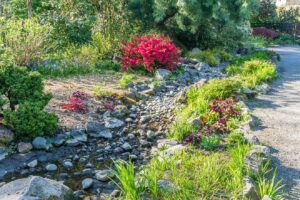 Install a dry creek bed to provide attractive and functional relief, especially if your landscape has standing water.
Install a dry creek bed to provide attractive and functional relief, especially if your landscape has standing water.
Dry creek beds are an excellent choice for addressing places in the landscape that are hard-hit by heavy rains. While a flat place in the yard may benefit more from a simple lawn drain, gradients and hillsides need the water capacity and speed that a dry creek bed can provide during extreme conditions. This drainage solution can be a nice addition to the look of your landscape by using different-sized rocks, boulders, and plantings.
French Drains
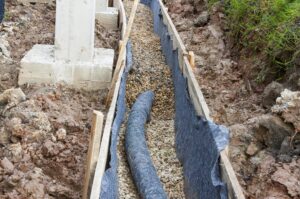 French drains are the most commonly used means of collecting, conducting, and discharging water. This is a trench filled with gravel, sand, or rock (depending on application) and containing a perforated pipe that redirects surface water and groundwater away from an area. The perforated (“weeping”) pipe also allows small amounts to seep into the ground along the way.
French drains are the most commonly used means of collecting, conducting, and discharging water. This is a trench filled with gravel, sand, or rock (depending on application) and containing a perforated pipe that redirects surface water and groundwater away from an area. The perforated (“weeping”) pipe also allows small amounts to seep into the ground along the way.
Frontier Landscaping offers landscape drainage services. We have years of experience with designing and implementing features that effectively carry water away from problem areas. Our expert installation team will determine the best place to collect excess water, the best method and route to conduct it, and an appropriate discharge point. We do the clean-up, too! Give us a call today!

Winter preparations need to be made for all aspects of your landscape, including your water features. Taking the time to protect your fountain or other outdoor water features from the risk of damage from water and freezing temperatures will protect your investment.
Size matters
If a water feature is large enough, it may be best to keep it running all year. This may be a necessity for water features containing fish. If you have a pond with fish, check during the winter to make sure there is a space for them to get oxygen if the water freezes over. To do this, you can get a de-icer that floats or aim the pump toward the surface to create an open area for the fish to breathe.
For smaller water features, it is easiest to drain and properly protect it for the season. Otherwise, water can settle, freeze, and expand, causing cracks or damage to your water feature.
Follow these simple steps to winterize your outdoor water feature:
- Empty the water from the water feature and make sure the pump is fully drained.
- Store the pump in a dry location like a garage or shed.
- Remove any leaves or debris.
- Use a cleaner such as Simple Green and scrub to remove dirt and algae.
- Dry it out with sponges or towels, or let it air dry.
- Remove any pieces that are unsteady or at risk of toppling over in the snow or wind.
- Get or make a cover for your water feature. Ideas include using burlap sacks, towels and a tarp, or a plastic waterproof cover. Tuck towels or covers into it, and then cover with a regular tarp or an appropriately sized waterproof cover.
- Secure with string to keep the cover taut. Make sure there is some airflow to the water feature and that it isn’t completely sealed.
Once spring arrives, it will be easy to get your water feature up and running again for another year of enjoyment.
At Frontier Landscaping we design, install, and maintain a wide variety of water features. We construct large multi-featured waterscapes as well as smaller, simpler set-ups. Give us a call for an estimate on your new water feature project.
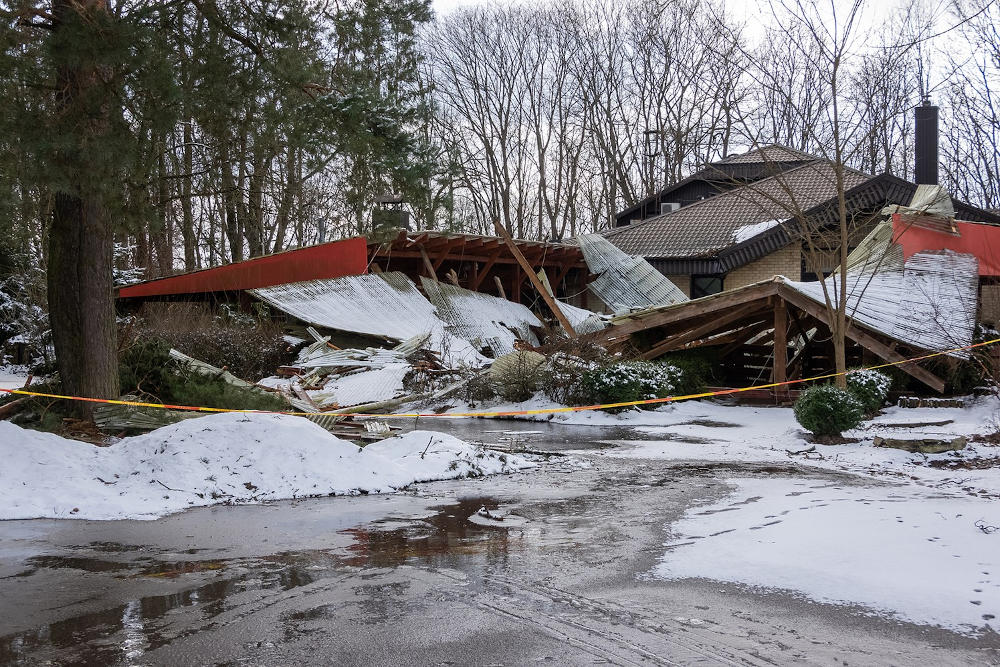
Your home is a huge investment worth protecting. Preventing property damage from winter weather should be a priority for homeowners. Rain, snow, ice, wind, freezing, flooding, fire – Mother Nature has many ways to cause problems. While you can’t control the weather, you can control how prepared your property is to safely weather the storm.
Cost of winter weather property damage
According to the Insurance Information Institute, 2021 winter storm damage caused over $1 billion dollars in insured property losses. This does not include uninsured property damage liability. It is important to read your homeowner’s insurance policy and understand what it does and does not cover if your property is damaged by weather. You may be surprised to see that it may not cover things like losses from landslides or erosion.
Property damage isn’t limited to physical damage to your home structure. Unfortunately, trees, plants, and other parts of your yard are often casualties. The ice storm of February 2021 alone caused the most tree damage of any storm event in the past 30 years!
Steps for preventing winter weather property damage
The good news is that your home and your yard don’t have to be casualties of winter weather. While you can’t stop hazardous weather from happening, you can prevent winter weather property damage with a little preparation:
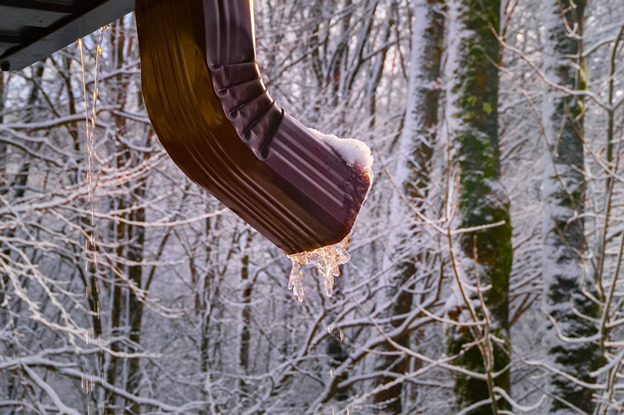
- Keep walkways and pathways clear. This goes for your driveway, sidewalk, and any areas of entry or exit around your home. Keep these free of any obstructions.
- Clean your gutters and downspouts. Make sure your gutters and downspouts are free from leaves and other debris so that water can easily flow off your roof and away from your house.
- Keep storm drains clear. During heavy rains, flooding can happen fast when water cannot properly drain from roadways. Keep an eye on this if you have a drain in front of your home.
- Don’t let snow and ice build up. Property damage is more likely to occur when snow and ice build up, not just from water but from weight. De-icer, a snow shovel or snow blower, and a roof snow rake to help with rooftop snow removal can all come in handy.
- Assess drainage and water pooling. Proper drainage is key to preventing flooding and water damage to your home. Sunken areas around your foundation or in your yard are high-risk for water accumulation. Drainage solutions like rain gardens or permeable pavers are not only effective, but can also add value to your property.
- Check for areas of erosion. Heavy rains can cause soil to wash away, increasing risk of flooding, landslides, and muddy messes. Installing retaining walls, culverts, or other landscaping features to aid with drainage can help prevent erosion.
- Trim and prune your trees. Remove dead, low-hanging, bowing, and damaged tree branches. Added weight from snow and ice is a recipe for broken branches and property damage. Cut back overgrown trees and plants that are too close to the house. Be sure to also check for high-risk branches overhanging your roof. Having a professional assess and prune your trees and plants is a worthwhile investment.
- Check for tree growth near power lines. NEVER remove these branches yourself. Contact your local power company about tree limbs that need to be pruned near power lines. Homeowners are generally responsible for trees growing near and around power lines. Power companies are responsible for trees touching or causing downed power lines. Removal of branches near power lines should be done by a tree trimming professional. The power company may shut off the power to the lines temporarily so pruning can be done safely.
- Winterize any outdoor spigots and irrigation elements. If indoor pipes are at risk of freezing, so are outdoor pipes. Make sure sprinkler lines and outdoor spigots are properly winterized.
- Secure anything at risk of becoming a projectile in high winds. This includes loose shingles, siding, fencing, lighting, and objects like lawn decorations, furniture, or swing sets. If you can’t nail it down or secure it into the ground, have a plan to store it when hazardous weather strikes.
Resources for dealing with weather-related property damage
In Washington:
In Oregon:
National:
Your home is a huge investment worth protecting. Keeping up on property maintenance is key to safeguarding your property against damage from hazardous weather.
For help with landscape and tree maintenance, property maintenance, residential or commercial cleanup, irrigation, erosion control and drainage solutions, contact us today!


Winter in the Pacific Northwest has already been a wet one. As temperatures drop, the risk of injury goes up. Snow and ice on your driveway, walkways, decks, and patios can create hazardous conditions for people and for pets. The cost of slip-and-fall injuries can be measured in time, money, and bodily pain. Just ask the one million Americans injured by slipping and falling annually.
While safely and effectively clearing snow and ice should be the priority, some methods are more plant and pet friendly than others. The key to using de-icers for snow and ice removal is to use as little as is necessary to effectively de-ice, while minimizing adverse impact on surrounding plants, and pets that frolic among them.
De-icing options
There are many different options for melting ice. The products most often used, and most widely available, generally contain some form of chloride. Minerals like sodium, potassium, calcium, and magnesium are combined with chloride ions to form salts used to melt ice. Other de-icing options include urea-based products, and calcium magnesium acetate (CMA), a chloride-free option. Each type of de-icer is effective down to a different temperature, and each type results in its own unique watery solution once the snow and ice melt.
Sand or gravel may provide increased traction on slippery surfaces by providing increased friction to prevent slipping. While application can help prevent formation of new ice, it does not cause snow or ice to melt.
Things to consider where de-icing is needed
It is important to consider the type and placement of plants along walkways, roadways, and any other areas where de-icing is often required. Younger, newer plants may be more susceptible to harm than older, more mature plants with well-established root systems. While unseen at this time of year, it is also important to consider the positioning of any bulbs planted in the areas where de-icing will occur. The melted water absorbed into soil can affect bulb growth of early spring blooms located in these areas.

Risk of harm from de-icers is highest with overuse and overapplication, regardless of which type is used. After applying de-icer, the resulting melted solution may be:
- Corrosive to metals, concrete, pavers, and other hard surfaces
- Scorching to plant leaves and flowers
- Suffocating to plant roots, with the salty soil preventing plant roots from absorbing the water necessary for growth and survival
- Toxic to pets, especially if more concentrated, making them sick when licked off paws after walking through it
- Polluting to waterways and marine life where storm drains bring this runoff water
With many options and factors to consider, doing your homework is necessary when it comes to the best de-icer solution for your individual situation. Whichever de-icing strategy you choose, remember that minimal necessary de-icer use is the key to maximal health for people, pets, and plants alike.
As always, the experts at Frontier Landscaping are here to assist with plant health needs. Call us today!

Christmastime is here again! Family and friends will gather to celebrate and be merry. Safety is also stressed this time of year — don’t drink and drive, plan ahead for winter weather, stay home if you are sick. But there are other risks to consider that you may not think about when it comes to decorating your home with holiday cheer.
The National Fire Protection Association reports that, between 2015-2019, U.S. fire departments responded to a combined average of 8.350 fires, causing 93 deaths, 708 injuries, and $314 million in direct property damage annually. The three main causes? Christmas tree fires, holiday decorations, and candles. Improper electrical connections and lights account for half of Christmas tree fires. The good news is that these fires are preventable with some easy steps towards holiday safety.
Follow these simple steps for holiday safety:
To stay safe indoors:

- Make sure your Christmas tree does not dry out. The needles should stay on when you touch them.
- Water your Christmas tree daily.
- Keep your Christmas tree at least three feet away from heat sources, like fireplaces, heating ducts, radiators, candles, and other lights, to name a few.
- Make sure that all exits are free and clear of the tree or holiday decorations.
- Check all lights for burnt out bulbs, faulty connections, or exposed wiring. Test them to make sure they work properly before hanging them on the tree or elsewhere.
- Indoor lights are for indoor use only, outdoor lights are for outdoor use only.
- Check to see how many light strands can be safely connected to each other. This is determined by the maximum conductivity rating and wattage of the outlet they are plugged into. Check out Backyard Boss’s guide for more technical information and the math equation to determine how many Christmas lights you can string together.
- Use a power strip with a surge protector. This will trip if the circuit is overloaded, and is easier to address than blowing a fuse for the house.
- Do not overload outlets or power strips.
- Always unplug lights and decorations before going to bed or leaving the house.
To stay safe outdoors:
- Use lights and decorations rated for outdoor use only.
- Use extension cords that are rated for outdoor use.
- When wrapping a tree in lights, start from the bottom of the trunk and work upward, finishing with the branches. There are online Christmas light calculators available to help determine how many lights you may need.
- Consider attaching lights with twine, wire or tape to outdoor trees to avoid damaging branches and ends.
- Staples should never be used to attach lights to trees. They damage the tree.
- Do not hang lights or decorations on newly planted saplings or young trees. The weight can damage them. Full, healthy trees only, please.
- Set your lights and decorations on a timer so that they are not on day and night. This reduces the risk of overheating and also prolongs their lifespan.
- Avoid injuries by keeping walkways well lit, and free of snow and ice.
- Take down your lights and decorations after the holidays. Leaving lights on trees or bushes year-round can impede growth and cause damage. This can also increase risk of wear and tear to the lights themselves, increasing fire risk when used again. Not to mention what squirrels could do….
After the festivities end
Come January 2022, it will be time to clean up and pack things away until next year. Real Christmas trees can be recycled. Local waste management companies have their own policies and procedures for tree disposal. Check with your local provider for specifics. There are various charities and organizations locally that provide recycling services:
May the warmth you feel together come from within, not from a holiday fire. Wishing you all a happy, healthy, and safe holiday season!

Fall is a wonderful time to add to your garden and prepare it for winter. Plants are less likely to get transplant shock than when planted in the warmer months, and there is no lack of rain to help establish good, strong root systems.
As we head towards winter and the leaves are falling, you may be noticing that your garden doesn’t have many flowers left. Perennials have finished blooming and are dying back. Most shrubs are also coming to the end of their flowering season. But a winter garden can also be filled with blooms. Careful selection of the right plants can ensure you a beautiful landscape all the way through the season.
Here are some plant selections that will thrive in the Pacific Northwest and bring beauty to your winter garden.

Daphne odora ‘Maejima’
Daphne odora ‘Aureo-marginata’
Variegated winter Daphne is a wonderful winter garden choice for our climate. There are many beautiful cultivars available for this plant. This evergreen shrub offers pretty, variegated foliage throughout the winter and will bloom in February and March and sometimes later. The flowers are highly fragrant and emerge in clusters of pink buds, opening to pale pink or white star shaped flowers.
Be sure to plant this shrub where it will get some afternoon shade and where drainage is good – in a raised bed or on a slight berm. Daphne enjoys rich, moist soil and infrequent watering throughout the summer months, once it is established. It is slow growing, so planting a bigger specimen is advised. It will grow to a height of 3-4 feet and a width of 2-4 feet.

Hamamelis x intermedia
Witch Hazels are a must for any winter garden. They start to bloom around January or February, depending on the species. There are many beautiful cultivars that will light up your winter garden, even when there is snow on the ground. Hamamelis x intermedia ‘Diane’ has deep orange and red flowers, and Hamamelis x intermedia ‘Arnold Promise’ has bright yellow spider-like blooms. Plant in full sun to part shade. These shrubs like moist, well-drained, acidic soil. Avoid letting the soil dry out. Witch Hazels also provide beautiful fall foliage colors for the landscape.
These luminous, deciduous shrubs come in various sizes but tend to reach around 12-15 feet tall and wide. Their flower color ranges from bright yellow to burnt orange or deep red. Hamamelis x intermedia varieties tend to have a longer bloom time with showier flowers than other species.
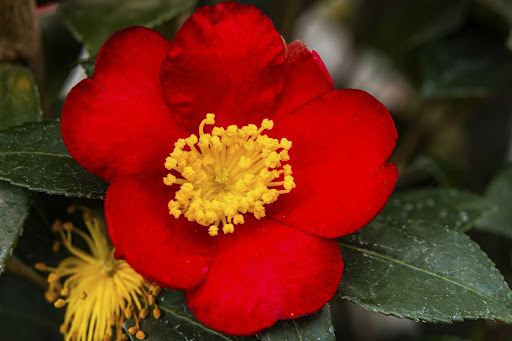
Camellia sasanqua ‘Yuletide’
The Yuletide Camellia is a great addition to bring color to a winter garden. It provides festive, bright red flowers, contrasting with deep green foliage during the holiday season and beyond. In fact, Camellia species in general are a great choice for winter gardens, providing attractive, glossy evergreen foliage and bright blooms of all colors. Sasanquas are particularly pretty, with their large, elegant blooms.
Camellia sasanqua ‘Yuletide’ should be planted in partial shade or filtered sun and in rich, acidic and well-drained soils. It is a moderate growing shrub, reaching around 5-8 feet tall and wide. It likes moderate and regular watering.
For more help selecting, planning and planting a winter garden, contact Frontier Landscaping.

There are so many tree species to choose from to add bright, vibrant, fall foliage color to your landscape. You may also want to consider adding some deciduous shrubs that will light up your garden in autumn. There are so many to choose from that making a selection can be confusing. It is worth strolling around your neighborhood in the fall to make note of the plants that are putting on their attractive seasonal display.
Here are some suggestions for deciduous shrubs that will give you bright reliable fall color here in the Pacific Northwest.

Euonymus alatus
The first choice of shrubs for fall color has to be the Burning Bush (Euonymus elata). This shrub grows so easily here – it is planted in parking lots and parking strips. It can also be planted as a hedge or as an individual specimen in mixed planting beds. You may have seen its bright luminous pink or red fall color blazing as you drive around town.
This shrub has attractive, deep green elliptical leaves and graceful branches that grow in a fountain shape, drooping down at the ends. E. alatus grows to a height and spread of 10-15 feet.
There is a smaller variety available if you don’t have space for a large shrub. Euonymus alatus ‘Compactus’ grows to a height and spread of 9-11 feet. Both of these shrubs like to be planted in full sun or part shade, preferring well-drained soil, while tolerating a range to different soil types. This shrub produces red berries that birds will enjoy in the fall.

Hydrangea quercifolia
The Oakleaf Hydrangea is a wonderful shrub to bring fall color to Pacific Northwest landscapes. There are many cultivars available in various sizes – you can be sure to find one to suit your garden.
Hydrangea quercifolia works well in woodland landscapes and doesn’t look as formal as the other Hydrangea species. The leaves are large and have a lobed shape, similar to that of many oak leaves.
From May to July, the Oakleaf Hydrangea develops large panicles of beautiful white, cream, or red flowers, depending upon the cultivar you choose. In the fall, the leaves turn an attractive deep red with shades of orange and purple. These shrubs should be planted in full sun to part shade. They like rich and well drained soils with consistent soil moisture. The species Hydrangea quercifolia grows to a height and spread of 6-8 feet.
There are many beautiful cultivars of Hydrangea shrubs for fall color available:
Hydrangea ‘Ruby Slippers’ has flowers that emerge white and then deepen to a dark pink. In the fall, the leaves turn a glowing red-brown color. This shrub grows to 3.5 feet tall with a spread of 4-5 feet.
Hydrangea ‘Munchkin’ is another dwarf variety that grows to a height and width of 3 to 4.5 feet. It prefers filtered light to partial shade. The blooms emerge bright white in color and mature to pink as summer continues. The leaves turn a brilliant deep red in fall.

Callicarpa americana
The last selection is also known as Beautyberry. This unique shrub has much to recommend it – vivid green foliage on arching, long branches in the spring, tiny clusters of lavender flowers in the summer (July-August), and bright magenta berries, highlighted by luminous yellow foliage colors in the fall.
This shrub grows to a height and spread of 3-6 feet – a good size for many landscapes. Plant it in full sun to light shade and in moist soil enriched with compost. This plant will grow well in clay soils.
Contact Frontier Landscaping for help selecting the right shrubs to bring fall color to your landscape.

Choosing a Focal Point Tree for Your Landscape
Focal point trees are trees that you can plant in your landscape that catch your eye and create beauty and drama throughout the seasons. Ideally, they shouldn’t be too big, unless you have a large property. Plant fairly close to your house, courtyard, or patio for maximum enjoyment. They can be planted in the ground – in a lawn, planting bed, or along a path. Depending upon the layout of your yard, another option is to plant in containers or raised beds.
Ideally, you’ll want to be able to glance out of your window and enjoy spring or summer flowers or bright fall colors. Focal point trees are usually broad-leaved deciduous trees that will bring seasonal change in the spring through to the fall. Some trees may even provide winter interest, providing interesting, leafless silhouettes and bark textures.

Show Stopping Spring, Summer, and Fall Color
There are quite a few small or medium sized tree choices that will provide you with almost year-round interest in the garden. Trees such as redbuds, ornamental cherry trees, crape myrtles, and even Japanese maples will give you enjoyment for much of the year.
Enhance Your Focal Point Landscaping with these Vibrant Tree Selections:
Redbud (Cercis canadensis)
There are many new cultivars of the Eastern redbud now available. Some are upright and some weeping, with beautiful cascading branches. Redbuds bloom in early spring with bright lavender-pink flowers along the branches, before the attractive, heart-shaped leaves unfurl. These trees are wonderful for wildlife and pollinator gardens, as they attract bees and hummingbirds, and birds feed on the long seed pods. Redbuds fit in well with PNW and woodland garden design styles.
- Cercis ‘Forest Pansy’ is a beautiful upright tree that grows 20-25’ tall and wide. It provides a show-stopping flower display in the spring. This is followed by striking burgundy leaves, and then a glowing golden yellow foliage display in fall.
- Cercis ‘Ruby Falls’ grows to around 6-8’ tall and 5-6’ wide. Like ‘Forest Pansy’ it also has the delicate, typical pea-family flowers clustered along its weeping branches in spring. These are a slightly pinker hue than those of ‘Forest Pansy’. The blooms are followed by deep purple leaves emerging along the branches, creating a wonderful cascading display in spring and summer. This is followed by luminous yellow fall color. The bare silhouette also provides interest in a winter garden.

Japanese Maples (Acer species)
Japanese Maples are an obvious choice for a focal point tree. There are plenty of cultivars that are small, both upright and weeping. They work well in Japanese-style gardens, woodland, or PNW gardens. Here are a couple of notable ones:
- Acer ‘Emperor 1’ is a wonderful choice for the Pacific Northwest. It grows up to 10-15’ tall and wide. The open, elegant crown doesn’t need much pruning. Its leaves emerge bright red in spring, deepening to an attractive purple. Plant where the tree can be backlit by early morning or late afternoon sun, which makes the foliage glow. The fall foliage display is a spectacular crimson red.
- Acer ‘Orangeola’ is a lace leaf maple and a spectacular choice for a focal point tree in a courtyard or small garden. It is also a good option to grow in containers or in the ground. It grows 4-8’ tall and 3-7’ wide. The leaves, which are deeply divided, emerge bright orange in the spring. They mature to a deep red, with highlights of green and orange in the summer. A fantastic burnt orange and fiery red appears in the fall.
- Acer ‘Sango Kaku’ is a great choice for year round interest. It grows to a height of 15-25’ tall and 15-20’ wide. This Coral Bark Maple provides a stunning upright silhouette in the winter with it’s beautiful orange-red bark. The leaves emerge a beautiful light green in the spring. In fall, the leaves turn a light, luminous yellow with tinges of orange, pink, and red at the margins.

There are many other trees that make great focal points in the garden. Check out our blog on
crape myrtles, for another great selection for a focal point tree in a hot, sunny location.
Frontier Landscaping can help you to enhance your property with focal point landscaping and aid you in planning and installing your landscape. Contact Frontier Landscaping today for more information.

































